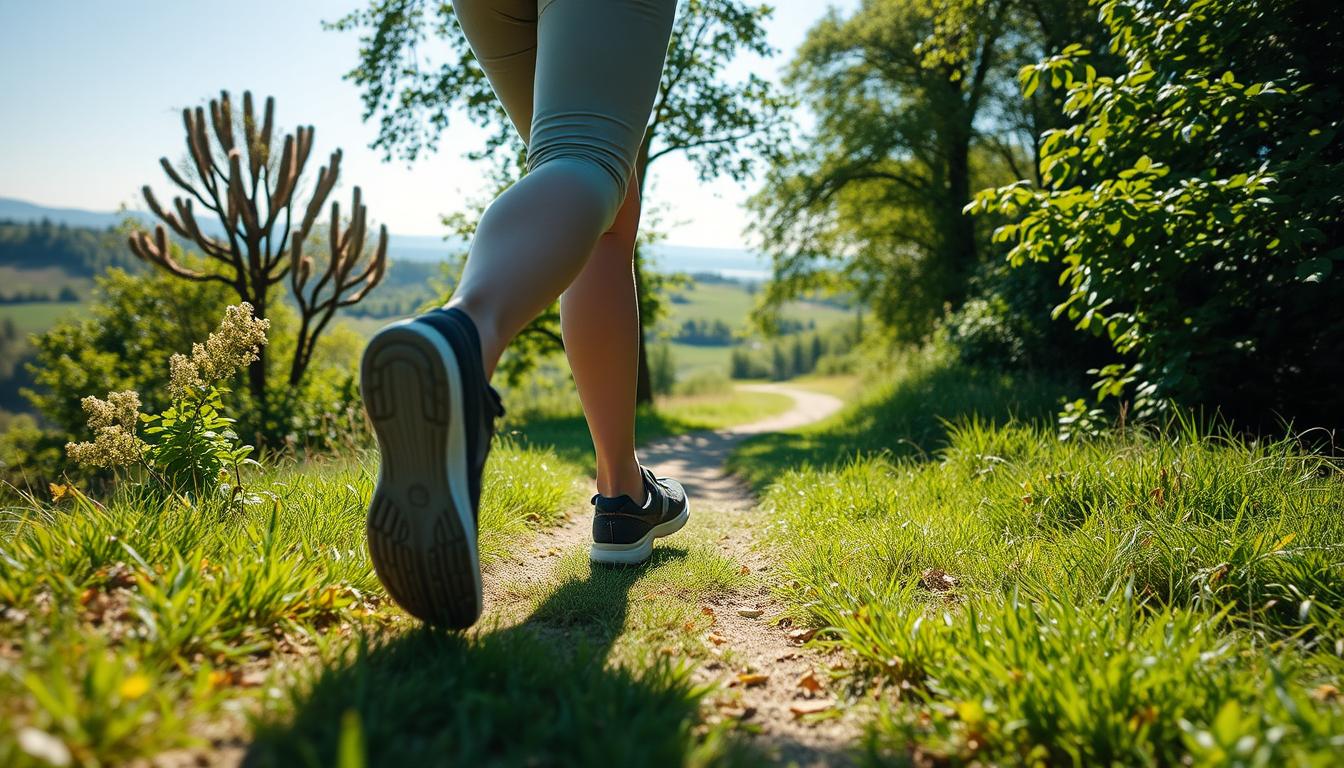Did you know walking 30 minutes a day can cut your heart disease risk by up to 50%? It’s a simple yet powerful way to improve your health. Your body changes in amazing ways when you walk every day.
Walking is more than just moving your feet. It’s a way to boost your physical and mental health. The benefits of walking daily are vast, affecting everything from your heart to your mind.
Walking daily can transform your body into a wellness powerhouse. You’ll see improvements in your metabolism, energy, and fitness right away. The best part? You don’t need fancy gear or a gym to start seeing results.
Key Takeaways
- 30 minutes of walking can significantly improve heart health
- Boosts metabolism and energy levels naturally
- Helps manage weight without intense workouts
- Reduces stress and improves mental well-being
- Accessible exercise for people of all fitness levels
The Science Behind Daily Walking Benefits

Walking is more than just a simple activity. It’s a powerful way to transform your body and boost overall health. When you commit to daily walking, you trigger a cascade of positive changes across multiple body systems.
Understanding how walking transforms your body reveals an incredible network of physiological improvements. These changes go far beyond basic movement. Your body responds to consistent walking with remarkable adaptations that enhance both physical and mental wellness.
Your Heart’s Best Friend
Walking for heart health delivers significant cardiovascular benefits. Regular walking can:
- Lower blood pressure
- Reduce bad cholesterol levels
- Improve blood circulation
- Decrease risk of heart disease
Muscle Transformation
Exploring what muscles walking tones reveals a full-body workout. Walking engages multiple muscle groups simultaneously, including:
- Quadriceps
- Hamstrings
- Calves
- Glutes
- Core muscles
Brain and Neural Enhancements
The effects of daily walking on your body extend to neural function. Regular walking stimulates brain health by:
- Increasing blood flow to the brain
- Promoting neuroplasticity
- Reducing cognitive decline risk
- Enhancing mood and mental clarity
By understanding these scientific mechanisms, you can appreciate walking as a comprehensive health strategy. It nurtures your body from the inside out.
Walking for 30 Minutes a Day: What Happens to Your Body?

Discovering what 30 minutes of walking can do for your body is like unlocking a secret wellness code. Your metabolism starts to transform, creating a cascade of positive health changes that ripple through your entire system.
When you commit to a daily walking routine, your body experiences remarkable shifts. Walking boosts your energy by triggering several physiological responses:
- Increased cardiovascular efficiency
- Enhanced metabolic rate
- Improved muscle tone and strength
- Better oxygen circulation
Your metabolism becomes more dynamic with consistent walking. Each step helps burn calories, regulate blood sugar, and support weight management. The magic happens when you make walking a regular habit.
“Movement is medicine for creating change in a person’s physical, emotional, and mental well-being.” – Greg Anderson
Health changes from consistent walking extend beyond physical benefits. Your body becomes more resilient, with improved immune function and reduced inflammation.
| Walking Duration | Metabolic Impact | Energy Boost |
|---|---|---|
| 30 minutes daily | 10-15% metabolism increase | 25% more daily energy |
| 45 minutes daily | 20-25% metabolism increase | 40% more daily energy |
Your body is designed to move, and walking is the most natural way to activate its full potential. Start your journey today and experience the transformative power of consistent walking.
Transform Your Physical Health Through Regular Walking
Walking is a powerful tool for transforming your physical health. It offers a simple yet effective approach to wellness. This can dramatically improve your body’s overall functioning. Whether you’re looking to lose weight, boost your metabolism, or enhance joint health, a consistent walking routine can be your key to achieving these goals.

Walking for weight loss and health isn’t just a trendy concept. It’s a scientifically proven method to improve your physical condition. When you engage in regular walking, your body begins to experience remarkable changes.
Weight Management and Fat Burning
Does walking burn fat? Absolutely! Walking is an excellent low-impact exercise that can help you shed unwanted pounds. Here’s how walking supports weight management:
- Burns approximately 150-300 calories per 30-minute session
- Increases metabolism for hours after your walk
- Helps reduce visceral fat around your abdomen
Improved Metabolism and Energy Levels
Your metabolism plays a crucial role in how your body processes nutrients and burns calories. Regular walking can significantly boost your metabolic rate. This helps you feel more energetic throughout the day.
| Walking Intensity | Calories Burned (30 min) | Metabolic Boost |
|---|---|---|
| Leisurely Pace | 100-150 calories | Mild |
| Moderate Pace | 200-300 calories | Moderate |
| Brisk Pace | 300-400 calories | Significant |
Enhanced Joint and Bone Health
Can walking change your body shape while protecting your joints? Walking is a low-impact exercise. It strengthens muscles around your joints, improves flexibility, and supports bone density. Regular walking can help:
- Reduce risk of osteoporosis
- Improve joint mobility
- Strengthen leg and core muscles
“Walking is man’s best medicine.” – Hippocrates
By incorporating a consistent walking routine, you can transform your physical health. Boost your metabolism and create a stronger, more resilient body.
Mental Health Benefits of Daily Walking
Walking is more than just exercise. It’s a powerful tool for mental wellness. Your daily 30-minute walk can change your mental health. It offers a natural stress therapy that boosts mood and brain function.
Walking has amazing mental health benefits. It releases endorphins and serotonin in your brain. These chemicals reduce stress and improve your emotional well-being.
- Reduces anxiety and depression symptoms
- Enhances overall mood and emotional resilience
- Promotes better sleep quality
- Increases mental clarity and focus
Walking as stress therapy creates a meditative space. It quiets your mind and helps you process emotions. The rhythmic motion and nature connection reset your mind.
| Walking Duration | Mental Health Impact |
|---|---|
| 15 minutes | Initial stress reduction |
| 30 minutes | Significant mood improvement |
| 45-60 minutes | Peak creativity and focus boost |
Your creativity gets a big boost from walking. The mix of movement and nature stimulates your brain. It sparks new ideas and problem-solving skills.
Walking isn’t just exercise – it’s a holistic approach to mental wellness that costs nothing and delivers immense benefits.
Adding walking to your daily routine improves your mental health. It goes beyond just being fit.
How Walking Boosts Your Immune System
Walking is more than just a simple exercise. It’s a powerful tool to boost your immune system and support long-term health. Regular walking can transform your body’s natural defense mechanisms. It helps you stay healthy and vibrant.
Strengthening Natural Defense Mechanisms
Walking for 30 minutes a day empowers your immune system. It increases the production of white blood cells. These cells are crucial in fighting off infections and protecting your body.
- Increases white blood cell count
- Enhances immune cell circulation
- Reduces stress-related immune suppression
Reducing Inflammation in the Body
The health benefits of regular walking extend to managing inflammation. Walking helps lower inflammatory markers in your body. This can prevent chronic diseases and support overall wellness.
- Decreases C-reactive protein levels
- Promotes better cellular repair
- Supports cardiovascular health
Supporting Long-term Health
Your walking and longevity connection becomes stronger with consistent exercise. By boosting your immune system with walking, you’re investing in a healthier future. This can potentially reduce the risk of age-related health issues.
“Walking is man’s best medicine” – Hippocrates
Just 30 minutes of walking can create a significant impact on your immune function. It makes walking an accessible and effective way to maintain your health.
Creating an Effective 30-Minute Walking Routine
Creating a simple walking routine for wellness is easy. It doesn’t matter if you’re new to walking or always on the go. Starting a daily walking habit can boost your health and energy.
Wondering how much walking is enough daily? Start with a 30-minute routine. Break it down into smaller parts for busy days:
- Morning walk: 10-15 minutes before work
- Lunch break walk: 10 minutes
- Evening stroll: 5-10 minutes after dinner
Beginners should aim for daily walks, not high speeds. Start slow and get faster as you go. Listen to your body and progress at your own rhythm.
Here are some tips for a great walking routine:
- Choose comfortable walking shoes
- Select varied walking paths
- Set realistic weekly goals
- Track your progress with a fitness app
The best walking routine is one you love and keep up with. Make it fun, try new places, and celebrate your wellness journey.
Maximizing the Benefits of Your Daily Walk
Walking is more than just moving your feet. To get the most out of your walks, focus on smart techniques. These can turn a simple stroll into a powerful way to improve your health.
Choosing the Right Time to Walk for Health
The best time to walk depends on your schedule and goals. Morning walks can kickstart your day. Afternoon walks refresh your mind. Evening walks help you relax.
- Morning walks: Ideal for metabolism boosting
- Midday walks: Mental refreshment break
- Evening walks: Stress reduction and wind-down activity
Perfecting Your Walking Form
To improve your posture, pay attention to your alignment. Keep your head up and shoulders relaxed. Use your core and swing your arms naturally. This not only prevents back pain but also makes your walk more effective.
Integrating Walking with Other Activities
Walking outdoors offers more than just exercise. You can do:
- Listen to podcasts or audiobooks
- Photography walks
- Social walking with friends
- Exploring local nature trails
Pro tip: Always wear comfortable shoes and stay hydrated during your walks to maximize your health benefits.
Common Mistakes to Avoid During Your Daily Walk
Walking is a great way to stay fit, but many people make simple mistakes. Knowing the right walking form and technique can make a big difference.
Walking is better than running for some people. But, to get the most out of it, you should avoid these common mistakes:
- Incorrect posture that reduces muscle engagement
- Walking too slowly without increasing intensity
- Neglecting proper foot placement and stride
- Skipping warm-up and cool-down routines
Many ask if walking is enough exercise. It depends on how fast and often you walk. Brisk walking daily can be very beneficial if done right.
To make your walking better, focus on these things:
- Maintain an upright posture with shoulders back
- Engage your core muscles while walking
- Swing your arms naturally to increase calorie burn
- Vary your walking speed and terrain
Brisk walking daily can improve your heart health, boost your metabolism, and clear your mind. By avoiding these mistakes, you can turn walking into a powerful workout.
| Walking Mistake | Correction Strategy |
|---|---|
| Slouching | Keep spine straight, chin parallel to ground |
| Slow pace | Aim for 3-4 mph moderate intensity |
| Flat terrain only | Include hills and varied surfaces |
Pro tip: Always listen to your body and gradually increase walking intensity to prevent injury and maximize fitness gains.
Building a Sustainable Walking Habit
Walking is a great way to improve your health every day. To make walking a habit, you need a plan and dedication. Start your journey to a longer life by creating habits that fit your life.
Creating a walking habit needs careful planning and smart strategies. The first step to a healthier life is to make walking fun and consistent.
Setting Realistic Goals
Begin your walking journey with goals you can reach. Here are some tips for setting goals:
- Start with 10-15 minute walks
- Gradually increase to 30 minutes
- Choose routes you enjoy
- Walk at the same time every day
Tracking Your Progress
Keeping track of your walks helps you stay motivated. Use these methods to see the benefits of daily walking:
| Tracking Method | Benefits |
|---|---|
| Smartphone Apps | Count steps, calories, distance |
| Fitness Wearables | Real-time activity monitoring |
| Personal Journal | Record emotional and physical changes |
Staying Motivated Long-term
To keep walking exciting, be creative and committed. Find walking buddies, explore new routes, and celebrate small victories to keep your routine fun and lasting.
“Every step is a step toward better health” – Walking Wellness Motto
Remember, walking every day is a journey. Be patient, stay consistent, and be kind to yourself as you work towards a healthier life.
Conclusion
Walking 30 minutes a day is more than just exercise. It’s a journey that changes your mind and body. It boosts your heart health and sharpens your mind. This low-impact workout is a complete way to improve your health.
Walking is the best low-impact workout because it’s easy and beneficial. You don’t need fancy gear or a gym. Just your neighborhood or a park can be your gym. Every step you take is a step towards better health.
Walking is simple and fits anyone’s lifestyle. It’s perfect for beginners or those who want to stay active. Start with short walks and increase your pace and distance as you get stronger.
Your path to better health starts with a simple walk. By making walking a daily habit, you’re not just moving. You’re building a lasting path to wellness. Take that first step today and see how walking can change your life, one step at a time.





